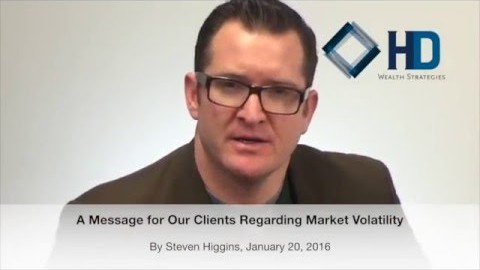Inflation, Volatility, But No Surprises
Four Reasons Why Inflation Will Continue to Drive the Story
by Steven Higgins
In February of 2017 I wrote in our annual review/preview that the economic narrative would begin to be driven by inflation and rising interest rates as opposed to the almost decade long story of record low interest rates.
In my opinion: Inflation and interest increases are coming. The timing is anybody’s guess, but they are coming nonetheless. The period ahead may be marked by increased volatility, as is common in inflationary environments. There may be times investors feel like they need to seek safety only to find the security of the harbor was no match for the tsunami. This is a time for investors, both retirees and pre-retirees, to gain an acceptance and understanding of how a diversified portfolio and normal volatility can help you reach your goals. I’m sure at some point, probably soon, we’ll have a correction.
–“Inflated Expectations” (March 1, 2017)
February 2018 brought the first 10% stock market correction in two years.* The normal – albeit sudden – volatility was spurred by fears that the Federal Reserve would aggressively raise rates in the light of a surprise uptick in inflation. Headlines read, “Fridays jobs report could carry inflation surprise” (www.cnbc.com), “Bond traders pay $6 million to hedge inflation surprise miss” (www.bloomberg.com), “Bond investors risk inflation surprise” (www.InstitutionalInvestor.com).
In every client meeting over the last year, we talked at length about the realities, risks, and potential opportunities that accompany inflation. We repeatedly stressed about how inflationary environments are volatile. We held several workshops in our office to educate people on the “new inflation narrative.” Our clients have real goals and dreams. Our job is to plan ahead, not just for today.
IT IS NOT TOO LATE! This inflation cycle has just begun and economic cycles like this can last a long time. This current period of low inflation started 35 years ago. The last “high inflation’ period in the 70’s and 80’s lasted over a decade.* Read on to hear our thoughts on four reasons why inflation will continue to drive our economic narrative.
*Source: Yahoo Finance
1. Over the last decade, money supply has increased 400% faster than the economy.*
Inflation – Noun – in-fla-tion \ in-ˈflā-shən \
a continuing rise in the general price level usually attributed to an increase in the volume of money and credit relative to available goods and services.
– Miriam Webster Dictionary
*Source: SEC filings, www.cnbc.com
2. Inflationary Policies Abound
With Republicans controlling the White House, Congress, and Senate, they have doubled down on the concept of deficit spending. Personal tax cuts, corporate tax cuts, increased military spending, and a proposed infrastructure plan all contribute to more money in the streets and a tighter job market. With the economy running at full employment, adding jobs will likely boost wages as companies and the government compete for workers. This will be good news for some, but the increased wages can lead to increased costs. Additionally, the flow of repatriated money from overseas has started. With lower corporate tax rates, large companies which had kept the cash hordes overseas to avoid paying the higher rates in the U.S. are now likely to bring some or all of that money back to the U.S. In our “Inflated Expectations” article last year, we noted that companies in the S&P 500 had amassed $2.5 trillion overseas. That money represents about 14% of the U.S. economy, roughly half of the entire economic growth of the last decade.*
*Source: SEC filings, www.cnbc.com
3. Lending “Sweet Spot”
Much talk has been made of rising interest rates and the impact on lending. Recent headlines speak of a slow down in mortgage applications because of increasing rates. While existing home sales have recovered nicely since the depths of 2010, they are still 20% lower than the highs in 2006*. New home sales are at only 50% of the highs in 2006**. A decade of building too few homes have left our nation in a major housing shortage. The “fix” isn’t coming anytime soon as building permits are still only about 63% of what they were in 2006**.
Combine the housing shortage with the reality that banks have been slow to lend money in an ultra low rate environment. There will certainly be a dip in mortgage applications in the immediacy of rates rising as people wait to see if they come back down as has been the case for several years, however low rates certainly have not resulted in more mortgages being issued. In fact, in 2016 which saw a 30 year mortgage rate at 3.75% there were fewer dollars lent via first lien loans than in 2006 when the 30 year mortgage rate was over 7.3%***. Additionally in 2006 government backed loans made up only 5% of all mortgages; today government loans make up 25% of all mortgages****. This is evidence of banks being super careful when it comes to lending. Essentially the banks are requiring super hero financials and credit scores or the backing of the Federal Government. It seems about right though. If you were the bank, would you take much risk just to make 4% per year over 30 years, especially if it looked like rates were going up? I hope not.
If banks issued more loans in 2006 when rates were higher it seems like there is a range where banks are willing to lend more and people are still willing to borrow. The size of the credit card market in the U.S. suggests that people borrow because of access to credit not because it’s the best deal. Additionally, home prices have risen substantially in many parts of the country. People may not be able to move, but they sure can tap that new found wealth they found in the equity in their homes. All that to say, the result will be even more money in the streets chasing a limited supply of goods and services. Inflation.
Sources: *National Assoc. of Realtors **U.S. Census Bureau ***Mortgage Bankers Assoc. of America ****CoreLogic
4. Household Formation: the Millennials are bring the economic “good stuff” to the Baby Boomer’s party.
Baby Boomers have ruled the roost for a long time. The mega generation that started after World War II is generally defined by births between 1946-1964. While the baby Boomer number peaked in 1999 at 78.8 million, it is still massive at 74.9 million people.* However, it is now the second largest living generation. The Millennials, roughly defined as those born between 1981-1998, are now the largest generation at 75.4 million strong.* The Baby Boomers have been an economic catalyst from the beginning. First it was diapers, now it’s health care. The Boomers have revolutionized every life stage and that’s probably not going to change. Take joint replacement for example. While once a major surgery, a new knee is simply now a pit stop in an active life. People are living in retirement nearly five times longer than they did 50 years ago and a big reason is advancements in health care.* Let’s face it, the Boomers have the money to try and live forever. When the Boomers fail to outfox mortality, do not worry, the Millennials will inherit their money.
*Source: www.pewresearch.org
The Millennials are no different. (For the record I am directly on the line of two generations; so much so that I can claim either. For this article, I’m not a Millennial.) We love to laugh at them. We think it is cute that they like to play grown up. We think they act entitled and so idealistic that they accomplish nothing practical. The image of skinny jeans on a retro bike toting an antique type writer and homemade paper with a $1,000 iPhone is too damn much! Well, Mr. & Mrs. Baby Boomer, you were a hippie before you made a bunch of money and suddenly started voting Republican. The millennials are basically functioning as world wide tech babysitters for you Baby Boomers. In fact, we have to employ them all over the world in order to help you sync your Fitbit at all hours of the day. (For this article I have chosen to be a Gen X – really cynical.)
What’s unique about the Millennials is that even though they are not being born any more, their numbers keep growing from immigration. As different as we like to think these idealist Millennials are, they are the same as every generation before. They want to create, to improve, to learn, to buy things, to have kids, to buy a new car, to buy a new phone, to buy a house, to buy an antique type writer, to buy a bigger house, to have more kids, and so on. As they begin to come to the table watch out!
We are encouraging our clients to prepare both financially and emotionally for the inflation cycle that may lie ahead. We believe practical money management and planning along with communication is the key. If you have investible assets of over $500,000 and are considering your investing future, you should have a talk with the advisors at HD Wealth Strategies. Check out our website for more details: www.HDWSColorado.com
The opinions voiced in this material are for general information only and are not intended to provide specific advice or recommendations for any individual. All performance referenced is historical and is no guarantee of future results. The opinions expressed in this material do not necessarily reflect the views of LPL Financial. The economic forecasts set forth in this material may not develop as predicted and there can be no guarantee that strategies promoted will be successful.













